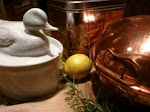When is it important to be delicate? The male instinct is to avoid such a characterization. Our male heroes are not delicate. There are no delicate football players, no delicate warriors, no delicate orators. Our role models may possess finesse and agility, but that is in applying strength and power. At home, we may act gently, with our infants or our lovers, but never delicately. Even delicate questions are never posed, they are either avoided or answered without asking.
In today's kitchen, many of our tastes are robust, fiery and forward. Southwestern spices are prominent, rustic dishes appreciated, basic colors and flavors asked to pop. Still, there is a cuisine and technique where delicate is the key. Flavors are hinted at, layered, perfumed. For me, that is Asian cooking, especially the preparations of Jean-Georges Vongerichten. His dishes reflect not the bold, loud flavors of a market or ethnic dance, but the gentle, soft textures of a water garden. His ingredients bubble, waft and scent. His dishes don't make you stand up and salsa, they make you close your eyes and tune into your senses. Lemongrass, kaffir lime, cilantro, basil, garlic, Thai chile, shallots, coconut, all applied softly, modestly, allowing each flavor to remain delicately, available, alluring.
Want to feel that way on a Tuesday night? All you need to do is prepare a dish like this. It includes a bed of eggplant for balance and color, and an herb crust for texture. Best of all, this isn't some sort of French veal sauce that must be cooked for a day and strained 20 times. This recipe from from Vongerichten's Asian Flavors cookbook is an easy, relatively short, and certainly straightforward preparation and presentation. It also makes it ok to be delicate. Serves 2.
Ingredients:
1 eggplant, cut into 1/2 cubes
salt
5 tbsp butter
1 red Thai chile, seeded and finely chopped
1/2 lemon grass stalk, trimmed and finely chopped
1 garlic clove, minced
1/2 cup panko bread crumbs
1 tbsp minced mint leaves
1 tbsp minced cilantro leaves
1 tbsp minced basil leaves
2 shallots, sliced
2 kaffir lime leaves, sliced
2 cod fillets
pinch of cayenne pepper
1/2 cup dry white wine
1/2 cup coconut milk
1 tsp lime juice
1/2 tsp fish sauce
Directions:
Preheat the oven to 450 degrees. Start a pot of water over high heat to boil for steaming the eggplant. In a colander, rinse and drain the eggplants. Generously sprinkle with salt, stir, and allow to sit for 20 minutes. Meanwhile, make a crust mix by heating 2 tbsp of butter in a skillet over medium heat. To the melted butter add half the chiles, 1/2 the lemon grass and the garlic and cook for 30 seconds to open the flavors. Add the bread crumbs and saute, stirring frequently until the breadcrumbs are lightly browned. Remove the bread crumbs to a bowl and allow to cool. Stir in the mint, cilantro and basil.
Rinse and drain the eggplants and then steam until tender, about 7 minutes. Set aside and keep warm.
Add 2 tbsp of butter to a large skillet over medium heat. Add the shallots, remaining chile and lemon grass, lime leaves and salt to taste. When the shallots are softened, season the cod with salt and cayenne and add to the pan. Add the wine and bring to a boil. Cover the skillet and transfer to the oven. Poach the fish, depending on thickness for 6 to 10 minutes. Test by piercing with a meat thermometer, holding in the fish for a few seconds, and then placing on your tongue. If it is warm, the fish is done. Turn the oven to broil and remove the fish. Transfer the fish to a baking sheet and return the skillet with the shallot mixture to the stove top over medium high heat. Add the coconut milk and cook until the sauce is reduced and thickened. About 5 minutes. Meanwhile, top each piece of fish with a layer of the crust mix. Add small pieces of the remaining butter on top and place under the broiler for a minute or two to heat the crust and brown a little more. To serve, put the eggplants on the plate first and place the fish on top. Stir into the pan sauce the lime juice and fish sauce to taste. Spoon around the fish and serve.




